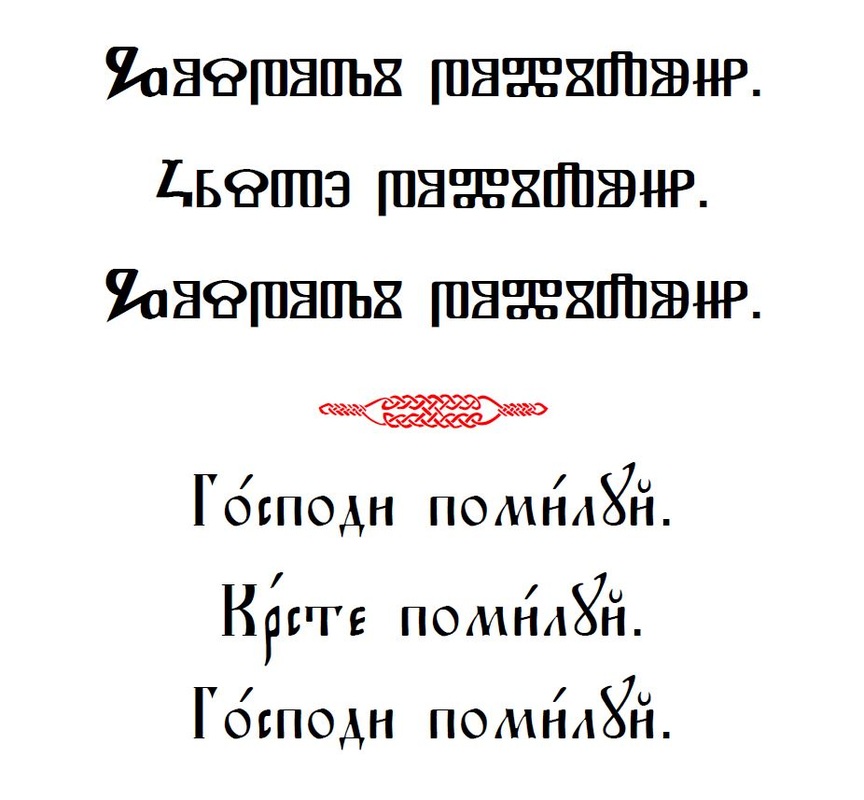LITURGICAL CHANT TRADITIONS
|
Antiphon for the Twenty-fifth Psalm.
THROUGHOUT the centuries, the Psalter has been the foundation of worship in all Orthodox temples in Christendom, and chant has been the holy nectar sweetening our praise to the Almighty One, in which we glorify Him with beauteous song, echoed by the Bodiless Hosts above, in unison with the faithful. To this Antiphon, add an ison or sonor on the E, and dip to a D on the F. Add another undertone with a B, dipping to an A on the F. Behold, the simplicity by which monophonic plainchant becomes polyphony. Though the lustre and magnificence of a true melody stands alone, enhanced in this way, it summons the Angels to join in chorus with us, as we extol Christ our God in perfect and heartfelt adoration, mingled with the outpouring of our sincere prayers, chanting in the splendour and glory of His holy house, ALLELUIA. https://www.youtube.com/watch?v=cO8WPfbjZvU |
Glagolitic Chant
The Litany
Gospodi pomiluj. Krste pomiluj. Gospodi pomiluj. (Lord, have mercy. Christ, have mercy. Lord, have mercy.) DURING the Middle Ages, in spite of the struggles of imposed Latin texts and Roman chant, the Slavs of the Dalmatian regions of the north western Balkans had preserved their liturgies inherited from their great teachers, the renowned holy brothers Cyril & Methodius. As a result, the Glagolitic Alphabet and chants survived, albeit in fallen western Christendom, and are still used, particularly on various islands in the east Adriatic Sea. https://www.youtube.com/watch?v=k4uHAYCBoyw https://www.youtube.com/watch?v=ZgkHBPG-8cE https://www.youtube.com/watch?v=Vvz9P20Do_4 |
Žumberak ChantThe Thrice Holy Hymn
Svjatij Bože, svjatij krepkij, svjatij bezsmertnij, pomiluj nas. (Holy God, Holy Mighty, Holy Immortal, have mercy on us.) THIS chant system and tradition is so named after the Žumberak Mountain region located in the northwest Balkans. Of somewhat mysterious origins, this style of chant is indigenous to the inhabitants of villages and towns throughout the area. Immediately noticeable is the similitude with local folkloric singing, which has always influenced and enhanced the liturgical worship of the Slavs in the execution of their chanting. https://www.youtube.com/watch?v=cumnjAYE3uw https://www.youtube.com/watch?v=CUS4zV_S9ls https://www.youtube.com/watch?v=0apJk1Cc_jM |
Carpatho-Rusyn ChantLET us who mystically represent the Cherubim, and chant the Thrice Holy Hymn unto the Life-creating Trinity, now lay aside all earthly care.
NAMED after the region in which it developed, Carpatho-Russian chant, or Prostopenie, includes elements of Znameny, Kievan and Byzantine chant, and passed down orally through the generations by means of congregational singing, has been preserved amongst the Carpathian Slavs. A leader, or cantor, often invokes the first phrase, and is joined by all present, again echoing their folkloric and rich traditions. https://www.youtube.com/watch?v=pzCvPqmEBBI https://www.youtube.com/watch?v=80rOOj7WZ-U |
|
The Thrice Holy Hymn
Ἅγιος ὁ Θεός, Ἅγιος ἰσχυρός, Ἅγιος ἀθάνατος, ἐλέησον ἡμᾶς. (Holy God, Holy Mighty, Holy Immortal, have mercy on us.) THE early church, born out of the community at Jerusalem, and arising from the catacombs, had long nurtured liturgies before Christianity became legal. Thus, named after the Empire which began to protect it, this chant developed and florished. Its own system of neums and text have preserved to this day the angelic-inspired hymns of praise. For centuries, the chant was monophonic, and eventually the ison developed and enriched it. https://www.youtube.com/watch?v=ODYgaPKryxk https://www.youtube.com/watch?v=k_ERnPk3E08 |
Antiphon to the Holy Cross
> Resurrectionem tuam laudamus et glorificamus. (Thy Cross, we venerate, O Lord, and Thy holy Resurrection we praise and glorify.) UNTIL it was gradually replaced with Gregorian plainchant, what we now call Old Roman chant was the standard used in the liturgies of the greater part of once Orthodox Italy and environs. Though Gregorian and other systems of western chant often have a more pentatonic structure, Old Roman chants are simpler, but with more ornamentation and melismatic embellishment. Enhanced with undertones, beauty and majesty is noticeably evident. https://www.youtube.com/watch?v=EUGg1rasDNs https://www.youtube.com/watch?v=hHRJ9booz5o |
The Thrice Holy Hymn
Qadisha Allaha, Qadisha Helthana, Qadisha Lamayota, itrahem alain. (Holy God, Holy Mighty, Holy Immortal, have mercy on us.) HERE we have one of the most ancient liturgical languages with one of the earliest Christian hymns. Preserved by ethnic Assyrians in the Caucasian country of Georgia (Iberia), on going persecutions of Orthodox Christians there has not extinguished the splendour and haunting echoes of this link to antiquity in the Middle East. The efforts of Schema-archimandrite Seraphim and his flock have been preserving and cultivating this living and mystic chant tradition. https://www.youtube.com/watch?v=E4XBKTK5crM https://www.youtube.com/watch?v=QUL4hoDdpgs https://www.youtube.com/watch?v=cKTqp55q7CE |








